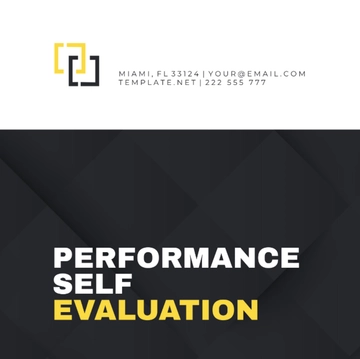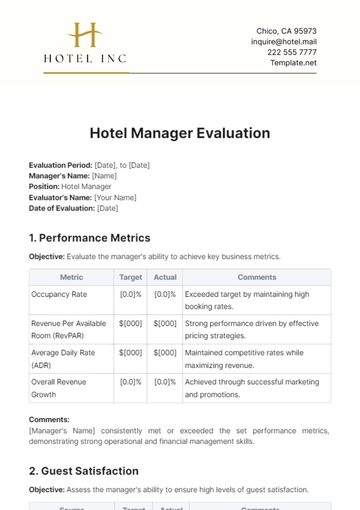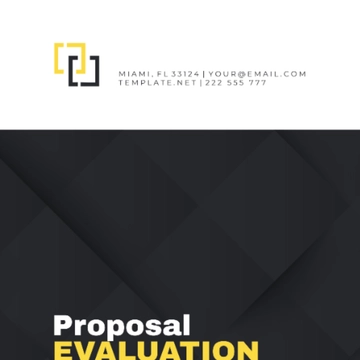Free Financial Performance Evaluation Report

Prepared by: [Your Name]
Company: [Your Company Name]
Date: [Insert Date]
This report evaluates the financial performance of [Your Company Name] for the fiscal year ending [Year]. The objective of this report is to provide a comprehensive analysis of financial metrics, including profitability, liquidity, efficiency, and solvency. This analysis aims to offer insights into the company’s financial health and inform stakeholders about its economic prospects.
I. Executive Summary
[Your Company Name] has shown significant growth over the past fiscal year. This section provides a summary of key financial metrics and performance indicators to set the stage for a detailed analysis in subsequent sections.
Metric | 2050 | 2051 | Change (%) |
|---|---|---|---|
Total Revenue | $200,000 | $250,000 | 25% |
Net Profit | $20,000 | $30,000 | 50% |
Gross Margin | 40% | 45% | 5% |
II. Profitability Analysis
Evaluating profitability involves analyzing how well the company is generating profit from its operations. The key metrics used in this analysis include net profit margin, return on equity (ROE), and return on assets (ROA).
A. Net Profit Margin
The net profit margin increased from 10% in 2022 to 12% in 2023. This indicates improved cost management and higher revenue efficiency. Factors contributing to this growth include effective price adjustments and a reduction in operating expenses.
B. Return on Equity (ROE)
ROE measures the profitability relative to shareholders' equity. The company’s ROE rose from 15% to 18%, reflecting effective utilization of shareholder capital and improved net income.
C. Return on Assets (ROA)
ROA increased from 5% to 7%, indicating better utilization of company assets to generate profits. This is primarily due to optimized asset management and strategic investments.
III. Liquidity Analysis
Liquidity analysis assesses the company's ability to meet short-term obligations using its current assets. Key metrics in this analysis include the current ratio and quick ratio.
A. Current Ratio
The current ratio improved slightly from 1.8 to 2.0. This suggests that the company has a stable capacity to pay off its short-term liabilities with its short-term assets, showcasing financial stability.
B. Quick Ratio
The quick ratio remained constant at 1.5, maintaining an optimal level of readily available assets to cover current liabilities without the need to sell inventory.
IV. Efficiency Analysis
Efficiency analysis focuses on how effectively the company uses its assets and liabilities to generate sales and maximize profits. The turnover ratios are crucial in this analysis.
Inventory Turnover: Improved from 5 to 6 times per year, indicating a more efficient sale of inventory.
Accounts Receivable Turnover: Increased from 8 to 10 times, demonstrating faster collection of receivables and stronger cash flows.
V. Solvency Analysis
Solvency analysis evaluates the company's ability to meet long-term obligations. Key indicators include the debt-to-equity ratio and interest coverage ratio.
A. Debt-to-Equity Ratio
Reduced from 0.5 to 0.4, reflecting a healthier balance between debt and equity financing, which minimizes financial risks and contributes to overall solvency.
B. Interest Coverage Ratio
Improved from 3.5 to 4.0, indicating stronger earnings capability to cover interest payments. This highlights the company’s reduced financial risk and stable financial footing.
VI. Conclusion
Based on the analysis of profitability, liquidity, efficiency, and solvency metrics, [Your Company Name] demonstrated robust financial health during the fiscal year ending [Year]. Continued focus on effective cost management, strategic asset utilization, and prudent financial strategies will ensure sustained growth and profitability in upcoming years.
VII. Recommendations
To further strengthen its financial position, [Company Name] should consider the following recommendations:
Enhance efforts to diversify revenue streams to mitigate market risks.
Continue optimizing inventory management to further improve turnover rates.
Explore opportunities to refinance existing debt at lower interest rates to further improve solvency.
- 100% Customizable, free editor
- Access 1 Million+ Templates, photo’s & graphics
- Download or share as a template
- Click and replace photos, graphics, text, backgrounds
- Resize, crop, AI write & more
- Access advanced editor





























